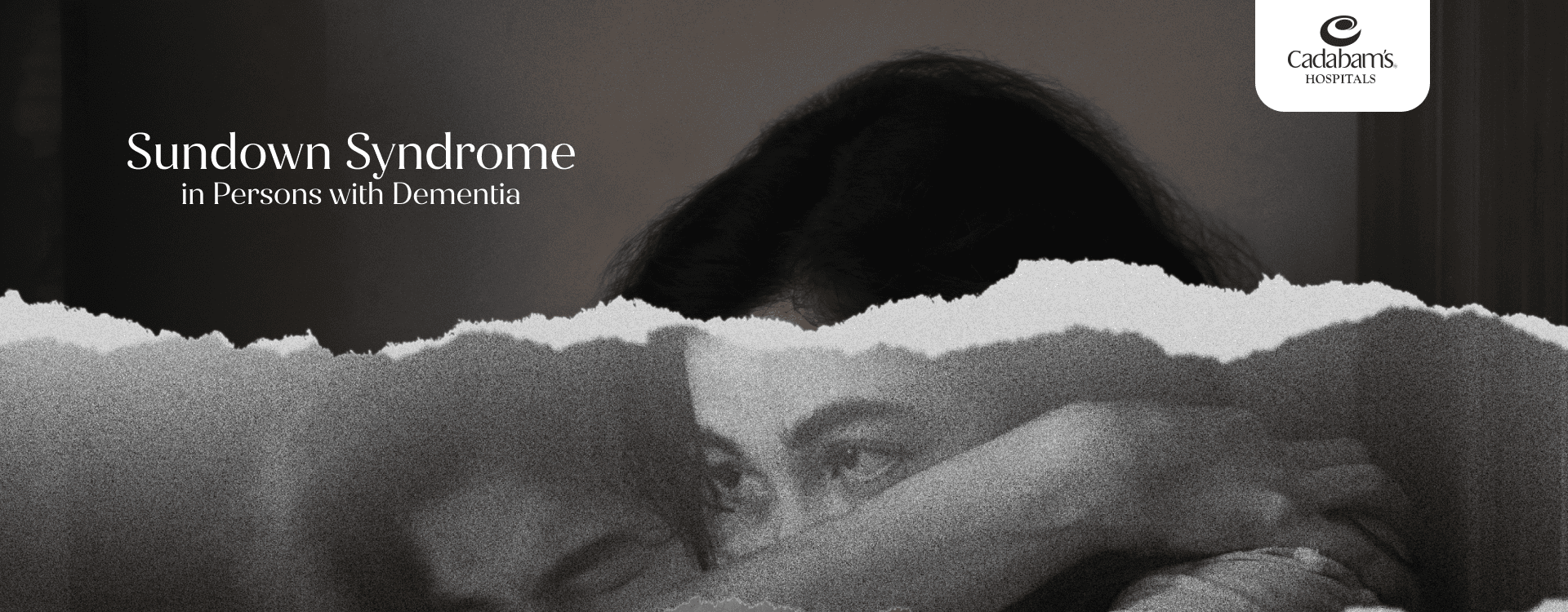Table of Content
Sundowners dementia is a unique clinical phenomenon seen in people with dementia. Sometimes, you may notice some changes in their behavior, such as intensely distressed, agitated, hallucinated, aggressive, or confused, mostly in the late afternoon or at night.
In this article, we will help you understand what is sundowning, its mechanisms, and why it is important for caregivers and healthcare professionals to be aware of its impact on patients. We will also help you with useful strategies to manage and support individuals experiencing sundowning.
What is Sundowners Syndrome?
Sundowner or sundowning is a term that refers to a state of confusion and related behavior in individuals experiencing dementia. This group of symptoms mainly occurs as the sun sets and may last for four hours or until the patient sleeps. Sundowning can happen at any stage of dementia, but it’s more commonly seen during the middle and later stages.
Common Symptoms and Signs of Sundowners Syndrome
In general, sundown syndrome is identified by not just one symptom but by a group of neurobehavioral symptoms such as mood swings, agitation, etc. So, let’s understand these symptoms and signs in detail.
Early Signs of Sundowners Syndrome
In the early stages of Alzheimer's and other types of dementia, the symptoms of sundown syndrome are not very noticeable, inconsistent, and can easily be missed. Some of the early signs that can give you subtle hints are restlessness, agitation, irritability, confusion, suspicion, and increased demands. Over time, these symptoms get worse and become more apparent.
Behavioral Changes and Agitation in Sundowners Dementia
When the sun is setting, sundowning carries apparent changes in the behavior of the person with dementia. These transformations can be displayed in a state of agitation, irritability, confusion, and even suspicion. They even may get upset or nervous easily, which will be quite challenging for both the caregiver and the patient.
Confusion and Memory Loss in Sundowners Dementia
It causes confusion and memory loss, especially in the evening. For example, someone with this condition might forget what they were doing just a while ago or may feel disoriented, especially in the evening. It’s like experiencing a mental block that gets worse as the condition progresses.
Anxiety and Mood Swings in Sundowners Dementia
Anxiety and mood swings are two of the most common and early signs of sundowning. Someone with the syndrome might feel anxious for no apparent reason and might switch from calm and serene to angry and agitated.
Delusions and Hallucinations in Sundowners Syndrome
As the day turns to evening, people with sundowning may experience delusions and hallucinations. They may start seeing things that aren’t there or start believing in things that aren’t factual. For example, they may hear voices or see things when nothing is around.
Shadowing in Sundowners Syndrome
Each person experiencing sundowning may exhibit different symptoms. One such symptom is shadowing, where the individual may follow their caregiver wherever they go.
Sleep Disturbances and Restlessness in Sundown Depression
Sleep disturbances and restlessness are common traits of sundowning syndrome. This may cause frequent awakenings, or inability to find a comfortable position, or may cause the person to wander around the house restlessly.
Causes of Sundowners Dementia
Sundowners dementia is a condition that is not yet fully understood by the scientific community. But it is thought to be a culmination of multiple causes, which include:-
Neurological Factors
Sundown depression may be connected to the modification in the brain caused by dementia and other related diseases. For example, disturbance in circadian rhythms or internal clocks can throw sleep into disarray. An imbalance in neurotransmitters can potentially influence cognitive functions and mood regulations, resulting in mood swings, agitation, etc.
Environmental and Social Triggers
There is a possibility that it may get triggered by things like feeble lighting, noise, or sudden changes in daily routine. The situation may get aggravated with feelings of loneliness and distress, which can heighten agitation and confusion.
Medications and Health Conditions
Specific medications or any underlying health issues, such as the presence of infection or pain, can contribute significantly to sundowning behavior. Consequently, deepening cognitive decline and overall well-being of a person with dementia.
Psychological and Emotional Influences
Stress, anxiety, and depression often accompany dementia as secondary effects that worsen sundowning conditions. This makes it more challenging for the individual to cope with their routine, and they may show aggression towards the caregivers.
Strategies for Reducing Sundowning Effect in Persons with Dementia
There is no specific treatment for sundowning effects in persons with dementia. However, there are strategies you can implement to reduce its effects, and these are:-
Establishing a Consistent Daily Routine
Setting up a consistent daily routine can help individuals with dementia. Waking up at the same time each day or having meals and bedtime at the regular timeframe can create a sense of security and help reduce confusion. Incorporating familiar tasks and activities that they enjoy into a daily routine can enhance engagement and well-being.
Creating a Calming Evening Environment
Building a calming evening environment can work wonders as it helps in easing up agitation and encourages relaxation. By setting up soft lights, lowering the noise levels, and establishing a predictable bedtime, you are sending a signal to their body that it’s time to rest and sleep.
Techniques for Managing Behavioral Symptoms
Identifying triggers like fatigue or discomfort and redirecting their attention to interesting activities can mitigate behavioral challenges in them. Utilizing calming techniques such as deep breathing exercises or gentle physical touch can soothe agitation. Besides, maintaining a structured environment with familiar objects and routines offers a sense of security and is also beneficial to validate feelings and provide reassurance.
Communication Strategies with Sundowning Patients
While communicating with sundowning patients, keep things simple, clear, and in short sentences, and always keep a calm tone. This will validate their feelings and offer reassurance. Keep in mind not to argue or correct them if they seem confused. A gentle touch or a reassuring smile too can convey understanding and support.
Support and Respite Care for Caregivers
Caregivers play a very important role in dementia patient’s lives. Thus, it is of utmost importance that you, as a caregiver, need to take care of yourself. Accessing support groups and respite care services and seeking support from your loved ones can provide you with needed relief and help you prevent burnout. This will ensure that you are offering quality care to your loved ones.
Utilizing Professional Care and Support Services
If you are finding it difficult to handle things or feeling overwhelmed, you can also get assistance from a healthcare professional. These professionals can provide customized assistance according to the requirement and offer expertise in managing symptoms, administering medications, and personalized care plans. So, if you are looking for professional help in managing dementia patients, contact healthcare professionals today and explore the best options for your loved ones.
Treatment for Sundowner’s Syndrome for People with Dementia
As mentioned above, there is no specific treatment currently available for Sundowner’s syndrome. However, treating the underlying triggers is the most effective way to manage the sundowing. Here are a few available methods for the same.
Medication Management
Presently, there is no single medication for sundowning, and what may work for one may not work for others. Some of the commonly prescribed medications include hypnotics, benzodiazepine, low-potency antipsychotics, etc. These medications should be used judiciously and under the supervision of healthcare professionals.
Behavioral and Cognitive Therapies
Behavioral and Cognitive Therapies are two science-backed therapies that are effective in treating mental conditions such as depression, anxiety, and stress. These symptoms are quite noticeable in sundowners dementia too, thus these therapies may help in managing underlying conditions.
Lifestyle Modifications and Home Care Strategies
Building a calming environment with soft lighting, minimizing noise, and establishing consistent routines can help manage sundowning. Engaging in soothing activities like listening to music or gentle walks can promote relaxation and reduce agitation in the evening.
Integrative and Holistic Approaches
Integrating complementary therapies like music therapy, tai chi, light therapy, or acupuncture can provide extra help in easing stress and boosting relaxation in individuals. These methods or practices are targeted to address the person's overall well-being and to improve their quality of life.
Integrating Physical Activity into Daily Life
Including gentle exercises like walking and stretching or yoga or enjoyable physical activities such as gardening into daily routines can improve sleep quality, reduce stress and anxiety, and boost overall health.
How to Help Someone Who Is Sundowning
Taking care of someone with dementia is challenging, but it becomes a lot tougher if the person has sundowning syndromes, too. Although you may not be able to reverse it completely, you can take precautions to reduce the impact on the person.
For example, when it gets dark, use softer room lighting. Keep the noise level to a minimum, and set aside regular time for outings, sleeping, exercise, visits, etc. Don’t let them consume alcohol or smoke. Set the room temperature at a comfortable level, play relaxing music, and take a leisurely walk.
A Path Forward in Sundowner’s Syndrome Care at Cadabams
Cadabams is among a few top places that lead the way in caring for sundowner’s syndrome, offering innovative approaches and specialized services to improve the lives of those affected. With over 30 years of experience, 400+ highly qualified professionals, and over 20 treatment modalities, offering personalized treatment and a supportive environment for patients and their families. Our state-of-the-art infrastructure and strong support system ensure world-class mental health care. Reach out to Cadabams today and take a step towards better care.
FAQ
1. How do you deal with sundowning in dementia?
To address sundowning in dementia, you prioritize creating a calming environment, maintaining consistent routines, and promoting relaxation techniques. Additionally, you can offer personalized care plans and medications as needed, all aimed at minimizing distress and improving the quality of life for individuals affected by this condition.
2. What stage of dementia is sundowning?
Sundowning typically occurs in the middle to later stages of dementia. It's more common in people with Alzheimer's disease but can also affect those with other types of dementia.
3. What triggers sundowning?
Sundowning triggers include changes in light, fatigue, and disruptions in the body's internal clock. These can lead to increased confusion, agitation, and restlessness in individuals with dementia or cognitive impairment, typically worsening in the late afternoon and evening.
4. Which items should be avoided to help with reducing sundowning?
To reduce sundowning, avoid caffeine and alcohol, limit sugar intake, and steer clear of stimulating activities close to bedtime. Creating a calm environment and maintaining a consistent daily routine can also help minimize symptoms.
5. What is the best treatment for sundowning?
The best treatment for sundowning varies based on individual needs. It often involves creating a calming environment, establishing a consistent routine, and potentially using medications under medical supervision to manage symptoms. Consulting with a healthcare professional is advisable for personalized recommendations.
How Cadabam's Help you for Addiction?
- 410+ Professional Consultants
- 1,00,00+ Happy Faces
- 120+ Currently Seeking Treatments





